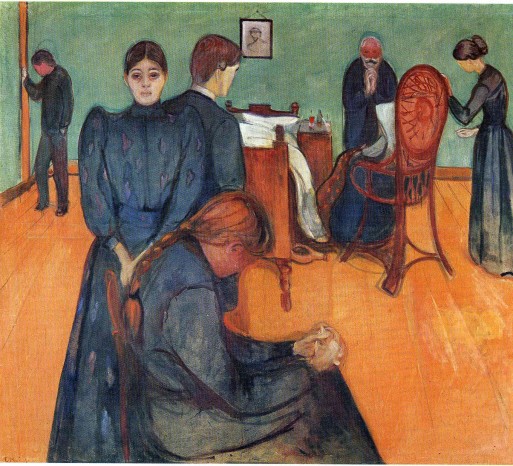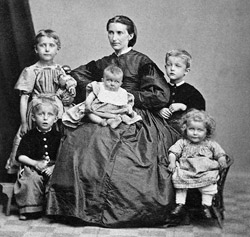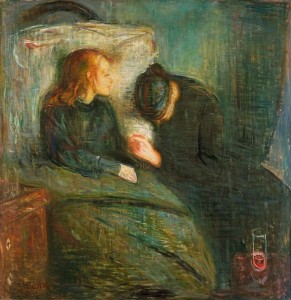In the 1895 painting Death in the Sick Room, Norwegian symbolist Edvard Munch takes a unique look at his sister Johanne Sophie and her death by tuberculosis. Rather than fix his gaze on his sister, Munch directs his attention to those surrounding her. The result is a scene with an expansive gaze on death, one that rejects the view of death a something transient – a brief spectacle – and more as a lengthy process that affects an entire family.
Edvard Munch was born into an aristocratic family in 1863 in Løten, Norway. The Munch clan was well-respected in the community for churning out churchmen and intellectuals. Ostensibly, young Edvard grew up in comfortable circumstances – but in truth, Munch said the high-strung, complicated nature of his family relationships caused him great pain:
“My father was temperamentally nervous and obsessively religious—to the point of psychoneurosis. From him I inherited the seeds of madness. The angels of fear, sorrow, and death stood by my side since the day I was born.”
–Edvard Munch, Behind the Scream
Munch played around with his painting style for many years, at times waxing impressionistic or naturalistic. It wasn’t until 1866, when Munch revealed a series of paintings titled The Sick Child, that he solidified his own symbolistic and expressionist style.
Like Death in the Sick Room, The Sick Child is also concerned with his sister Johanne Sophie (1867-1877) and her tuberculosis. The girl’s painful dying process shook the painter to his core, as her death would become one of many in an already unstable family. By the time Munch’s father had died, the painter reflected, “[first] my mother, my sister, my grandfather, [and now] my father… I live with the dead.”
We don’t really see Johanne Sophie in Death in the Sick Room – just a glimpse of her back in a chair as she is tended to by Edvard’s praying father.
In a way, you could argue that we see Johanne Sophie’s presence everywhere: in the hovering posture of her aunt, Karen Bjølstad (depicted to the right of Johanne Sophie) and the melancholy gaze of sister Inger, whose eyes meet the viewer in the forefront of the painting. We see the resonance of her illness on Edvard himself, who depicted himself as the concerned, quarter-faced figure in the center. The dying girl is surrounded by her family, but in a way that demonstrates their strained relationships; not a single family member touches another.
In “Modern Art and Death,” Carla Gottlieb writes:
“….the [family’s] faces are contorted, not in mourning but in fear of the unknown, fear for themselves who are eventually to meet the same fate [of death]. In this agony, each person is alone; each survivor turns away not only from the dead but also from the other participants in the scene. Faced with death, the family bonds fall apart, revealing their superficial character. Thus Munch experienced death as dissolving family ties…”
The color scheme of the painting heightens the sense we have of Johanne Sophie’s illness: the walls are a stale green, the floor a noxious orange. The figures wear cool tones of blue and green, with traces of Munch’s under-painting climbing up from the dresses’ hemlines as if to say, “this is a moment of ghostly transparency, a moment where the immensity of death and dying will make anything else irrelevant.”
Edvard Munch lived a creative life, but it was passed in tandem with a string of deaths. Contracting tuberculosis is no longer as grave as it was in the 1800s, but let Munch’s painting prompt us to consider what our own “sick room” would look like. How would we envision the tableau of our own dying process? Let Death in a Sick Room become inspiration – a call of action, even – to foster positive relationships with our loved ones that will provide support, and not isolation, as we near death.
You may enjoy:
- A SevenPonds post on Frida Kahlo’s unique relationship with death and sickness.
- A SevenPonds exploration of Marc Chagall’s painting “The Death”
- A SevenPonds article on the enigmatic painting “Death of Harlequin” by Pablo Picasso.

 “Death in the Sick Room” by Edvard Munch
“Death in the Sick Room” by Edvard Munch






 John Mulaney’s “Funeral Planning” on Netflix: No Real Plan
John Mulaney’s “Funeral Planning” on Netflix: No Real Plan

 Composting Bodies Is Now Legal in a Dozen States
Composting Bodies Is Now Legal in a Dozen States














